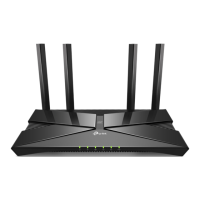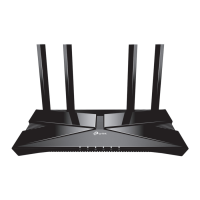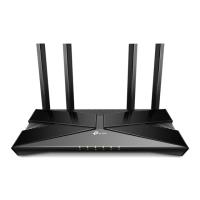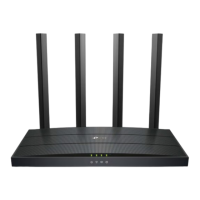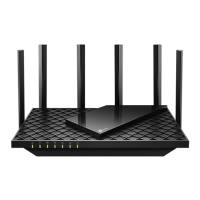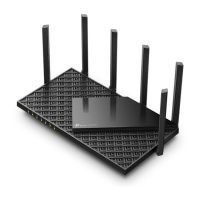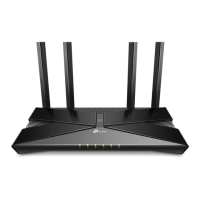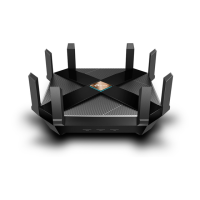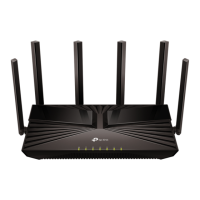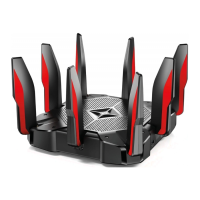Do you have a question about the TP-Link Archer AX95 and is the answer not in the manual?
Introduces the router's capabilities, technology, and ease of use.
Details the router's physical components, ports, and LED indicators.
Guidelines for optimal router placement to ensure performance and safety.
Instructions for connecting the modem, router, and power adapter.
Methods for connecting a computer via wired or wireless connections.
Using the WPS button for easy wireless device connection.
Step-by-step guide to accessing the router's web management page.
Automated wizard for easy internet connection setup.
Configure various connection types like Dynamic IP, Static IP, PPPoE.
How to configure the router to function as an access point.
Guides on setting up different IPv6 connection types provided by your ISP.
Steps to create, bind, and manage your TP-Link ID for remote access.
How to use the TP-Link Tether app for router management on mobile devices.
Using the Network Map to view internet and device status.
Viewing and controlling client devices, including speed limiting.
Setting up SSID, password, and security for wireless networks.
Scheduling automatic turn on/off of the wireless network.
Using WPS for simple and secure wireless connections.
Configuring advanced settings like WMM, Airtime Fairness, and Beacon Interval.
Steps to set up a secure guest Wi-Fi network with custom options.
Setting up a captive portal for guest network access with custom branding.
How to access USB devices locally and remotely.
Enabling media sharing for DLNA devices to play content from USB.
Setting up Time Machine backups for Mac computers to the router.
Utilizing HomeShield for network protection against malicious attacks.
Setting up content filters, time limits, and access restrictions for family.
Using HomeShield tools to analyze and optimize network performance.
Configuring the SPI Firewall to protect against cyber threats.
Blocking or allowing devices using Blacklist/Whitelist for network access.
Binding IP/MAC addresses to prevent ARP spoofing and attacks.
Making local resources accessible via the internet using port forwarding.
Dynamically opening ports for applications like online games via port triggering.
Exposing a PC to the internet with all ports open using DMZ.
Enabling UPnP for smoother online gaming and real-time communications.
Setting up an OpenVPN server for secure remote access to the home network.
Configuring a PPTP VPN server for remote access and client connections.
Setting up a secure L2TP/IPSec VPN server for remote access.
Configuring the router as a VPN client to connect to remote VPN servers.
Changing the router's LAN IP address to avoid conflicts.
Setting up the router for IPTV services using IGMP or VLAN.
Managing the DHCP server and reserving IP addresses for devices.
Configuring DDNS for remote access using a domain name.
Manually configuring static routes for advanced network traffic management.
Steps for upgrading router firmware via auto, online, or local methods.
Backing up, restoring, and resetting router configuration settings.
Changing the router's web management login password.
Using Ping and Traceroute to diagnose network connectivity issues.
Setting the router's system time from the internet or manually.
Scheduling automatic router reboots for performance optimization.
Enabling Night Mode to turn off router LEDs during specified hours.
Introduces the router's capabilities, technology, and ease of use.
Details the router's physical components, ports, and LED indicators.
Guidelines for optimal router placement to ensure performance and safety.
Instructions for connecting the modem, router, and power adapter.
Methods for connecting a computer via wired or wireless connections.
Using the WPS button for easy wireless device connection.
Step-by-step guide to accessing the router's web management page.
Automated wizard for easy internet connection setup.
Configure various connection types like Dynamic IP, Static IP, PPPoE.
How to configure the router to function as an access point.
Guides on setting up different IPv6 connection types provided by your ISP.
Steps to create, bind, and manage your TP-Link ID for remote access.
How to use the TP-Link Tether app for router management on mobile devices.
Using the Network Map to view internet and device status.
Viewing and controlling client devices, including speed limiting.
Setting up SSID, password, and security for wireless networks.
Scheduling automatic turn on/off of the wireless network.
Using WPS for simple and secure wireless connections.
Configuring advanced settings like WMM, Airtime Fairness, and Beacon Interval.
Steps to set up a secure guest Wi-Fi network with custom options.
Setting up a captive portal for guest network access with custom branding.
How to access USB devices locally and remotely.
Enabling media sharing for DLNA devices to play content from USB.
Setting up Time Machine backups for Mac computers to the router.
Utilizing HomeShield for network protection against malicious attacks.
Setting up content filters, time limits, and access restrictions for family.
Using HomeShield tools to analyze and optimize network performance.
Configuring the SPI Firewall to protect against cyber threats.
Blocking or allowing devices using Blacklist/Whitelist for network access.
Binding IP/MAC addresses to prevent ARP spoofing and attacks.
Making local resources accessible via the internet using port forwarding.
Dynamically opening ports for applications like online games via port triggering.
Exposing a PC to the internet with all ports open using DMZ.
Enabling UPnP for smoother online gaming and real-time communications.
Setting up an OpenVPN server for secure remote access to the home network.
Configuring a PPTP VPN server for remote access and client connections.
Setting up a secure L2TP/IPSec VPN server for remote access.
Configuring the router as a VPN client to connect to remote VPN servers.
Changing the router's LAN IP address to avoid conflicts.
Setting up the router for IPTV services using IGMP or VLAN.
Managing the DHCP server and reserving IP addresses for devices.
Configuring DDNS for remote access using a domain name.
Manually configuring static routes for advanced network traffic management.
Steps for upgrading router firmware via auto, online, or local methods.
Backing up, restoring, and resetting router configuration settings.
Changing the router's web management login password.
Using Ping and Traceroute to diagnose network connectivity issues.
Setting the router's system time from the internet or manually.
Scheduling automatic router reboots for performance optimization.
Enabling Night Mode to turn off router LEDs during specified hours.
| DSL WAN | No |
|---|---|
| Ethernet WAN | Yes |
| WAN connection type | RJ-45 |
| Wi-Fi band | Tri-band (2.4 GHz / 5 GHz / 5 GHz) |
| Top Wi-Fi standard | Wi-Fi 6 (802.11ax) |
| WLAN data transfer rate (max) | 7800 Mbit/s |
| WLAN data transfer rate (first band) | 574 Mbit/s |
| WLAN data transfer rate (third band) | 4804 Mbit/s |
| WLAN data transfer rate (second band) | 2402 Mbit/s |
| Product type | Tabletop router |
| Product color | Black |
| VPN server | OpenVPN, PPTP, L2TP |
| Networking standards | IEEE 802.11a, IEEE 802.11ac, IEEE 802.11ax, IEEE 802.11b, IEEE 802.11g, IEEE 802.11n |
| Ethernet LAN data rates | 10, 100, 1000, 2500 Mbit/s |
| Ethernet LAN interface type | Gigabit Ethernet |
| Number of guest networks (5 GHz) | 3 |
| Number of guest networks (2.4 GHz) | 1 |
| Antennas quantity | 8 |
| Processor cores | 4 |
| Processor frequency | 1700 MHz |
| USB 2.0 ports quantity | USB 2.0 ports have a data transmission speed of 480 Mbps, and are backwards compatible with USB 1.1 ports. You can connect all kinds of peripheral devices to them. |
| Firewall security | SPI Firewall |
| Security algorithms | WPA, WPA-Enterprise, WPA2, WPA2-Enterprise, WPA3 |
| Package type | Box |
| Number of products included | 1 pc(s) |
| Power source type | DC |
| Storage temperature (T-T) | -40 - 70 °C |
| Operating temperature (T-T) | 0 - 40 °C |
| Storage relative humidity (H-H) | 5 - 90 % |
| Operating relative humidity (H-H) | 10 - 90 % |
| Depth | 183.9 mm |
|---|---|
| Width | 277.3 mm |
| Height | 57.3 mm |
